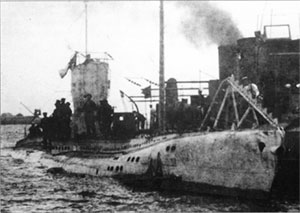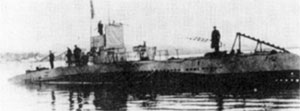
Seiner Majestät UB-4 was a German Type UB I submarine (U-boat) in the German Imperial Navy during World War I. She was sunk by a British Q-ship disguised as a fishing smack in August 1915.

The Type UB I submarine was a class of small coastal submarines (U-boats) built in Germany at the beginning of the First World War. 20 boats were constructed, most of which went into service with the German Imperial Navy. Boats of this design were also operated by the Austro-Hungarian Navy and the Bulgarian Navy. In the Austro-Hungarian Navy, it was called the U-10 class.
The Austro-Hungarian U-boat fleet was created in the decade prior to the First World War. They were built to a variety of designs, many under licence from Germany. They served throughout the war against Italian, French and British shipping in the Mediterranean Sea with some success, losing eight of the twenty eight boats in service in return. They were reinforced by the Imperial German Navy’s Pola Flotilla, mainly comprising coastal U-boats transported by rail from Germany's northern shipyards to the Austrian ports on the Adriatic Sea. Following the end of the war in 1918, all Austrian submarines were surrendered to the Entente powers, who disposed of them individually. As both Austria and Hungary became landlocked in the aftermath of the war, no Austrian or Hungarian submarines have been commissioned since.
SM U-68 was a Type U 66 submarine or U-boat for the German Imperial Navy during the First World War. She had been laid down in December 1913 as U-9 of the U-7 class for the Austro-Hungarian Navy but was sold to Germany, along with the others in her class, in November 1914. Under German control, the class became known as the U 66 type and the boats were renumbered; U-9 became U-68, and was redesigned and reconstructed to German specifications. She was launched in June 1915 and commissioned in August.

SM U-4 or U-IV was a U-3-class submarine or U-boat built for and operated by the Austro-Hungarian Navy before and during the First World War. The submarine was built as part of a plan to evaluate foreign submarine designs, and was the second of two boats of the class built by Germaniawerft of Kiel, Germany.

The U-10 class was a class of five submarines or U-boats of the Austro-Hungarian Navy during World War I. The class was similar to the German Type UB I submarine of the German Imperial Navy ; the first two boats delivered to Austria-Hungary had previously been commissioned in the German Navy.

SM U-10 or U-X was the lead boat of the U-10 class of submarines for the Austro-Hungarian Navy during World War I. She was originally a German Type UB I submarine commissioned into the German Imperial Navy as SM UB-1.
SM U-15 or U-XV was a U-10-class submarine or U-boat of the Austro-Hungarian Navy during World War I. U-15 was constructed in Germany and shipped by rail to Pola where she was assembled and launched in April 1915. She was commissioned in October 1915. U-15 was the most successful boat of the U-10 class, sinking six ships totaling 8,044 gross register tons (GRT) and 745 tons. The boat survived the war and was handed over to Italy as a war reparation and scrapped in 1920.
SM U-66 was the lead ship of the Type U-66 submarines or U-boats for the Imperial German Navy during World War I. The submarine had been laid down in Kiel in November 1913 as U-7, the lead ship of the U-7 class for the Austro-Hungarian Navy. They became convinced after the outbreak of war in August 1914 that none of these submarines could be delivered to the Adriatic via Gibraltar, and sold the entire class, including U-7, to the German Imperial Navy in November 1914.
SM U-69 was a Type U 66 submarine or U-boat for the German Imperial Navy during the First World War. She had been laid down in February 1914 as U-10 the fourth boat of the U-7 class for the Austro-Hungarian Navy but was sold to Germany, along with the others in her class, in November 1914.
SM U-67 was a Type U 66 submarine or U-boat for the German Imperial Navy during the First World War. She had been laid down in November 1913 as U-8 the second boat of the U-7 class for the Austro-Hungarian Navy but was sold to Germany, along with the others in her class, in November 1914.
SM U-70 was a Type U 66 submarine or U-boat for the German Imperial Navy during the First World War. She had been laid down in February 1914 as U-11 the final boat of the U-7 class for the Austro-Hungarian Navy but was sold to Germany, along with the others in her class, in November 1914.
SM U-28 or U-XXVIII was a U-27-class U-boat or submarine for the Austro-Hungarian Navy. U-28, built by the Austrian firm of Cantiere Navale Triestino (CNT) at the Pola Navy Yard, was launched in January 1917 and commissioned in June.
SM UB-47 was a Type UB II submarine or U-boat for the German Imperial Navy during World War I. UB-47 was sold to the Austro-Hungarian Navy during the war. In Austro-Hungarian service the B was dropped from her name and she was known as SM U-47 or U-XLVII as a member of the Austro-Hungarian U-43 class.

SM UB-43 was a Type UB II submarine or U-boat for the German Imperial Navy during World War I. UB-43 was sold to the Austro-Hungarian Navy during the war. In Austro-Hungarian service the B was dropped from her name and she was known as SM U-43 or U-XLIII as the lead boat of the Austro-Hungarian U-43 class.

SM UB-42 was a Type UB II submarine or U-boat for the German Imperial Navy during World War I. UB-42 operated in the Mediterranean and the Black Seas during the war. She was broken up at Malta in 1920.
SM UB-12 was a German Type UB I submarine or U-boat in the German Imperial Navy during World War I. The submarine disappeared in August 1918.

SM UB-2 was a German Type UB I submarine or U-boat in the German Imperial Navy during World War I. She sank eleven ships during her career and was broken up in Germany in 1920.

SM UB-6 was a German Type UB I submarine or U-boat in the German Imperial Navy during World War I. The submarine was interned after running aground in neutral Dutch waters, and was scuttled by her crew at Hellevoetsluis.
SM UB-7 was a German Type UB I submarine or U-boat in the German Imperial Navy during World War I. She disappeared in the Black Sea in September 1916.






